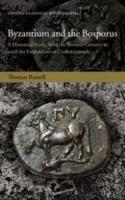
OUP (2017) h/b 290pp £75.00 (ISBN 9780198790525)
R. thinks it is all too easy to say that Byzantium, or Sicily, were important because of their position in the Mediterranean world. They are ‘important’ because of their unique local conditions and how they are exploited, and R. seeks to show the relationship between Byzantium and the Bosporus by means of regional studies using a wide array of evidence, particularly Dionysius of Byzantium’s wonderfully detailed Anaplous.
As a result we know that currents, winds and coastal topography forced the seasonal passage of massive shoals of fish, which were caught on an almost industrial scale by nets fixed in the flow, producing a surplus for export, a preserving industry, and income for the state from selling licences to fish. The same conditions, of course, also produced (un)safe periods for ships navigating the Bosporus. Athens typically monopolised such an opportunity in the fifth century. She needed grain from the Black Sea area; the ships carrying it deserved guidance and protection from pirates and Spartans; Athens deserved the kick-back she got from providing the service (‘protection’); Byzantium got stung by astronomic levels of tribute payable, though Athens’ efforts were hugely beneficial to Byzantium, too. And even if the pirates did not appear, ships could get caught up in one of the ‘elbows’ where the ship was drawn close to the land. And with batheia that peppered the coastline (here inlets rather than depths), they were sure to find a safe harbour and all the facilities needed to separate them from their well-earned.
Such a good opportunity was open to further exploitation, and Byzantium effectively devalued foreign coinage and ran an enclosed market that ensured everything cost you, the harassed sailor, too much. In fact, it was so good that the Egypt got in on the act, supporting Byzantium with its own issues. It is also clear how this ‘bottom-up’ version of historiography clarifies and explains international relationships and involvements in a way different from more traditional approaches.
R. goes on to examine the growth of Byzantium through its institutions, relations with Thrace, the nature of its citizenship, its festive calendar, adding up to a developing self-view. Byzantium, for example, (and others) adopted and adapted myth to present itself as an Hellenic city, of Hellenic foundation, though R. will not accept the concept of colonies established instanter, but describes a developing process of habitation, growth and the formation of its own, unique story.
There is a lot to like about this book: readers will find it as refreshing as the reviewer did. It is not a chronological history, and it is written observing the tenets of so-called ‘learning technology’—in essence, tell ’em what you are going to tell ’em, tell ’em, then tell ’em that you’ve told ’em. It makes for very efficient learning, but it also introduces a considerable amount of repetition that the reader should be aware of. Forget that: here is something new, daring and utterly involving.
Adrian Spooner
